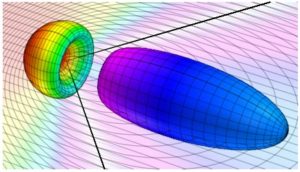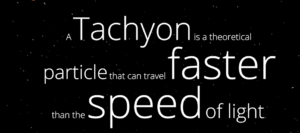Tachyon
Is there a possibility of something travelling faster than the light? Maybe there is, maybe there isn’t.
Let’s talk about a possibility like that, a hypothetical particle. A particle which has the strength of moving faster than light (the fastest traveller).

This very particle being called Tachyon. Tachyon –comes from the Greek word, Tachy meaning ‘Rapid’
This unusual idea was brought out by physicists, O.M.P. Bilaniuk, V.K. Deshpande and E.C.G. Sudarshan naming it “Meta-particle” in 1962.
In 1967, Gerald Feinberg proposed that these particles could be a quanta of quantum field having imaginary mass. But in a very short period of time, it was realised that excitation of this doesn’t propagate faster than the light. It rather is a presentation of an unstable particle called tachyon condensation.
Till date, no evidence has been found proving its existence. Still, in modern physics, TACHYON plays a significant role.
Let’s enter the world of science and study about some of the fundamental models related to this unexplainable particle.
Something from the history:
Gerald Fienberg, the originator of the Tachyon concept was initially inspired by a sci-fi story BEEP by James Blish. He studied kinematics of the particles with respect to the special relativity.
The 1st hypothesis regarding to the faster than light particles are sometimes dedicated to the German physicist Arnold Sommerfield in 1904.
After that in 2011(September), there was a report of tau-neutrino travelling faster than light (released by CERN). Later on, on the OPERA project it was indicated that these reports were the results of a faulty element of the experiment’s fibre optic timing system.

Fields with imaginary mass
The Lorentz invariant quantum fields with imaginary mass explains some aspects of it.
The combined velocity of this field is faster speed than light, it slightly tilts towards the theory of a particle existing as such. But an individual particle won’t stand this theory’s weight and the negative mass represents a negative mass and all excitations of the field propagates subluminally and are consistent with causality.
Lorentz-violating Theories
Those who do not believe in Lorentz’s theories, believe that light is not a hinderance, rather there is a complete possibility of a particle existing which can travel faster than the light without infinite energy or a casual paradox.
Fields with non-canonical kinetic term
By modifying the kinetic energy of the field, the possibility of producing Lorentz invariant field theories with excitations that propagate superluminally.

-Simran Sarin



1 Comment
Source · May 22, 2018 at 4:16 pm
I’m so happy to read this. This is the kind of manual that needs to be given and not the accidental misinformation that is at the other blogs. Appreciate your sharing this greatest doc.